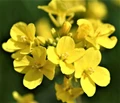
Following a 44 percent increase in mustard crop diversification in the 2021-22 rabi season, enterprising farmers are now earning profits by selling the yield for up to Rs 7,000 per quintal, a 28 percent increase over this year's MSP and an all-time high for the crop in Punjab.
The low-cost input mustard crop is crucial in water conservation, according to agricultural specialists and progressive farmers.
Nachatar Singh, 31, of Bathinda's Naruana village, had cultivated mustard for the first time on 12-acres he had leased, yielding an average of 7 quintals per acre. His cotton fields were afflicted with pink bollworm during the previous kharif, or summer crop season, and he incurred losses.
"In comparison to previous yields of 12-16 quintals per acre, the average cotton output was devastated to 4 quintals. Then, during the rabi season, I took a calculated gamble and switched to mustard instead of wheat. Oilseed cultivation helped to mitigate prior losses to a degree, and I've chosen to grow mustard on a larger scale in October this year," he added.
According to data from the state agricultural department, mustard was grown on an estimated 1.34 lakh acres in 2021-22, the most in the past 15 years. However, it was 70% less than in 1974-75, when the state's total mustard acreage was 4.4 lakh acres.
Farmers have been planting mustard on roughly 30,000 hectares (74,000 acres) every year since 2007. Farmers have begun sowing to diversify the rabi crop cycle, according to Agriculture Director Gurvinder Singh, following a concerted push by state officials for crop diversification.
"We're working on a plan to boost oilseed agriculture, which has a great market potential," he said.
Mustard is the finest alternative rabi crop for the semi-arid areas of south Malwa, according to Gurcharan Singh of Muktsar's Udekaran village.
"In comparison to wheat, which requires irrigation five or six times, mustard only requires irrigation once or twice." Because this area relies heavily on the canal system and the groundwater table has fallen to dangerous levels, mustard is the most cost-effective option. Gurcharan, who cultivated oilseed for the first time in 45 years, claimed it is "less labour demanding and more remunerative than wheat."
Baldev Singh of Bathinda's Bajak village, like Gurcharan, has stockpiled up on all of his produce in anticipation of increased oilseed prices.
"Mustard, a non-perishable crop that can be preserved for months, minimises soil chemical load and is more ecologically sound than wheat." "After processing, husk pays roughly Rs 3,000 per acre, which is more than the real mustard harvesting cost," he noted.
Baldev believes that the government's organised intervention in purchasing the produce will help to stabilise the market and boost farmers' motivation to diversify their crops.
"In comparison to wheat, which requires irrigation five or six times, mustard only requires irrigation once or twice." Because this area relies heavily on the canal system and the groundwater table has fallen to dangerous levels, mustard is the most cost-effective option. Gurcharan, who cultivated oilseed for the first time in 45 years, claimed it is "less labour demanding and more remunerative than wheat."
Baldev Singh of Bathinda's Bajak village, like Gurcharan, has stockpiled up on all of his produce in anticipation of increased oilseed prices.
"Mustard, a non-perishable crop that can be preserved for months, minimises soil chemical load and is more ecologically sound than wheat." "After processing, husk pays roughly Rs 3,000 per acre, which is more than the real mustard harvesting cost," he noted.
Baldev believes that the government's organised intervention in purchasing the produce will help to stabilise the market and boost farmers' motivation to diversify their crops.
Farmers may continue to obtain high rates in the coming months, according to Rakesh Rathi, a renowned trader and mustard miller, as demand for oilseed has surged owing to the Russia-Ukraine war and Indonesia's restriction on palm oil export.
"India's cooking oil needs are primarily imported, and the worldwide trend has driven higher mustard and oil crop rates. In the Malwa region and elsewhere, the government should encourage the cotton-mustard combination to break the wheat-paddy cycle and conserve water, according to Rathi.
Fazilka had the biggest mustard crop in 2021–22, with 37,000 acres planted, an increase of 80 percent over the previous rabi season.
According to Bala Ram of Fazilka's Saidanwali village, mustard has a lower cost input than wheat and is more profitable.
"Wheat requires an estimated investment of Rs 12,000–Rs 15,000 per acre, whereas mustard only roughly Rs 7,000 per acre." This year's wheat output was down 20%, but the alternative mustard is providing farmers a dividend," he explained.











